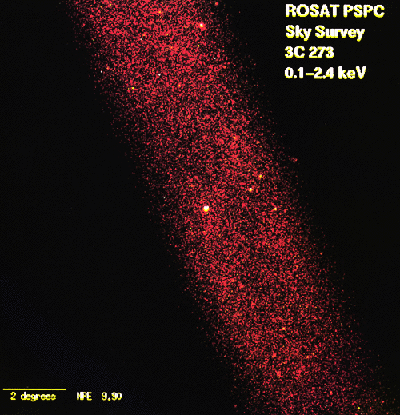3C 273

3C 273 is a rather historic quasar. In fact, the history of the word "quasar": itself might bear some explaining. In the early 1960's, a class of mysterious radio-loud objects with an ultraviolet excess in color was discovered by Alan Sandage. At that time, no one knew what these strange objects could be, as they were star-like in size and had variable brightness, yet were radio sources. It wasn't until 3C 273 was identified as one of these bizarre radio sources that things began to happen. Maartin Schmidt discovered that its spectral lines were shifted by 16%; this translates to a redshift of .16. 3C 273 was 1.5 billion light years away from the sun, and was receding even further at a rate of 47,000 kilometers per SECOND. This odd object was further away and more luminous than most known galaxies!
The first of these objects discovered were all very strong radio sources and were called "quasi-stellar radio sources"; this was shortened to "quasar" by a NASA physicist. Later on, Alan Sandage realized that other strange blue objects that had been previously discounted because they were radio-quiet, were most likely quasars as well. Not all quasars were radio sources! So in modern astrophysics, quasars are usually referred to more correctly as QSOs, or "Quasi-Stellar Objects".
Curator:
HEASARC Guest Observer Facility
Please use the Feedback link if you have questions on ROSAT.

